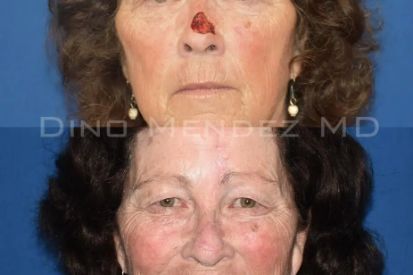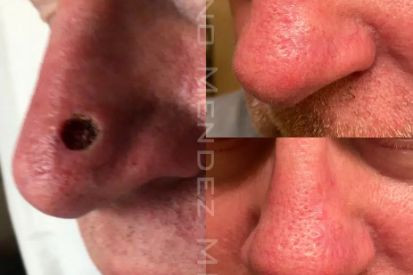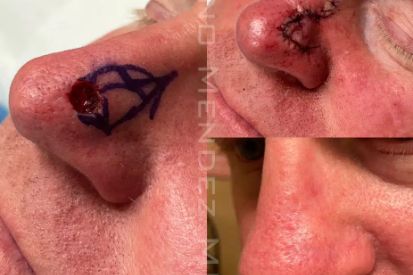Reconstruction After Mohs Surgery
Restoring Skin and Function with Reconstruction After Mohs Surgery
Reconstruction after Mohs surgery is a specialized procedure to restore the skin's appearance and function following the removal of skin cancer. Mohs surgery is highly effective in removing cancerous tissue while preserving as much healthy skin as possible. However, reconstruction may be necessary to minimize scarring, restore the natural contours of the face or body, and ensure proper healing. This reconstruction may involve techniques such as skin grafts, local flaps, or suturing, tailored to the size and location of the affected area.


Reconstruction After Mohs Surgery Explained
Plastic surgery can be used to reconstruct the wound left behind by Mohs surgery. Various techniques can be used depending on the size and location of the defect. Reconstructive surgery provides an ideal surgical result and promotes proper healing. Particularly when performed by a plastic surgeon, whose training is intimately tied to the reconstruction of the head and neck, as well as creating aesthetically pleasing results.
Once your Mohs surgery is complete, the plastic surgeon will examine your defect and discuss the options for healing with you. Several options for reconstruction may be considered including primary closure, rotation of adjacent tissue, or placement of a skin graft taken from another area on the body.
This process aims to achieve the best possible cosmetic and functional results, utilizing various techniques such as sutures, flaps, or grafts. The choice of reconstruction method depends on the size and location of the excised tissue, ensuring not only the elimination of cancer but also the preservation of the skin's appearance and functionality.
Benefits of Reconstruction After Mohs Surgery
- Cosmetic Restoration: The primary benefit involves restoring the natural appearance of the skin, minimizing scarring, and preserving aesthetics.
- Functional Integrity: Reconstruction aims to maintain or restore the functionality of the treated area, ensuring proper mobility and preventing limitations in daily activities.
- Minimized Discomfort: Proper reconstruction contributes to a smoother healing process, reducing discomfort and promoting a more comfortable post-operative experience.
- Enhanced Self-Esteem: Achieving a favorable cosmetic outcome often leads to increased self-confidence and a positive impact on emotional well-being.
- Reduced Recurrence Risk: By ensuring thorough removal of cancerous tissue and effective closure of the surgical site, reconstruction contributes to minimizing the risk of cancer recurrence.
How Cumberland Skin Can Help
If you've undergone Mohs surgery and require reconstruction, schedule a consultation with our experienced team today. At Cumberland Skin, we are dedicated to helping you regain confidence in your skin.
Examples of Reconstruction After Mohs Surgery






Warning
This content contains sensitive images.
Reconstruction After Mohs Surgery FAQs
During your initial consultation, your surgeon will provide you with a specific timeline, as the reconstruction process timeline varies based on factors such as the size and complexity of the surgical site. Some reconstructions are completed immediately after Mohs surgery, while others may require additional appointments.
While some scarring is inevitable, skilled surgeons aim to minimize its visibility by employing careful techniques. Scars typically fade over time, and post-operative care instructions contribute to optimal healing.
There may be some discomfort during the recovery process, but with prescribed pain medication, it is usually manageable. During your initial consultation and after your surgery, your surgeon will give you pain management recommendations to ensure your comfort throughout the healing process.
Most patients can resume normal daily activities within a week, but strenuous activities should be avoided for a few weeks. Your surgeon will provide specific guidelines based on your individual case.
Depending on individual circumstances, reconstruction can sometimes be combined with other cosmetic procedures. Taking your skin and cosmetic goals into considerations, your surgeon will create an individualized treatment plan to share with you at your consultation.
From Our QualDerm Family of Brands: Reconstruction After MOHS Surgery
What to Expect at Your Reconstruction After Mohs Surgery Appointment
The surgeon will carefully explain the chosen reconstruction technique, address any concerns, and provide information on the expected healing process. Post-operative care instructions, including recovery expectations and follow-up appointments, will be discussed to ensure a successful and comfortable experience throughout the reconstruction journey.
How to Prepare for Reconstruction After Mohs Surgery
Wear comfortable clothing on the day of the procedure, and ensure transportation arrangements, as you may not be able to drive yourself home after receiving any necessary anesthesia. Create a supportive recovery space at home and consider bringing a trusted friend or family member to the appointment to absorb the information provided and offer assistance during the recovery process.
This thoughtful preparation ensures a smooth and well-informed experience as you embark on your reconstruction journey following Mohs surgery.
Planning for Recovery after Reconstruction After Mohs Surgery
· Preventing infection by keeping the incision clean and covered, as instructed by your surgeon
· Avoiding strenuous activity or heavy lifting until healing is complete
· Reducing swelling and bruising
· Avoiding UV radiation
Regular follow-up with your dermatologist is imperative after Mohs surgery.
Featured Products

EltaMD UV Clear SPF 46
Oil-free EltaMD UV Clear helps calm and protect sensitive skin types prone to discoloration and breakouts associated to acne and rosacea. It contains niacinamide (vitamin B3), hyaluronic acid and lactic acid, ingredients that promote the appearance of healthy-looking skin. Very lightweight and silky, it may be worn with makeup or alone. Choose from tinted and untinted formulas for use every day. 1.7 oz / 48 g

iS Clinical Pro Heal Serum Advance+
Pro-Heal Serum Advance+ features our scientifically advanced L-Ascorbic Acid (Vitamin C), combined with a superior form of Olive Leaf Extract and pure Vitamins E and A. This powerful formulation significantly increases antioxidant protection while helping improve the appearance of compromised, blemish-prone, and aging skin. 30 mL e 1 fl. oz.
Featured Products

iS Clinical Pro Heal Serum Advance+
Pro-Heal Serum Advance+ features our scientifically advanced L-Ascorbic Acid (Vitamin C), combined with a superior form of Olive Leaf Extract and pure Vitamins E and A. This powerful formulation significantly increases antioxidant protection while helping improve the appearance of compromised, blemish-prone, and aging skin. 30 mL e 1 fl. oz.

SkinCeuticals Triple Lipid Restore 2:4:2
Aging skin is increasingly susceptible to lipid depletion: the loss of natural compounds in skin's surface, present in the form of ceramides, natural cholesterol, and fatty acids. This lipid loss compromises skin's natural protective barrier. 1.6 fl oz / 48 mL
Related Blog Posts

- Cosmetic Treatments
At Cumberland Skin, our dermaplaning treatment boasts many benefits for the skin and is often more affordable than other types of cosmetic treatments. To learn more about what dermaplaning is and how it can improve your skin, keep reading.
Read More
- General Dermatology
- Skin Care
- Cosmetic Treatments
Explore various treatment options available for scars and stretch marks in this comprehensive overview of both non-invasive and medical procedures. Make informed decisions about addressing these common skin concerns.
Read More
- Skin Cancer
- General Dermatology
- Skin Exams
- Sun Safety
Uncover the unparalleled benefits of Mohs surgery. Learn how this precise technique ensures minimal tissue removal while maximizing cancer removal rates, offering patients superior outcomes in skin cancer treatment.
Read More

